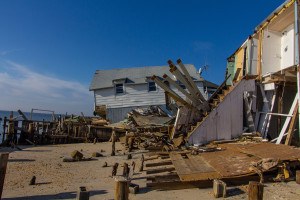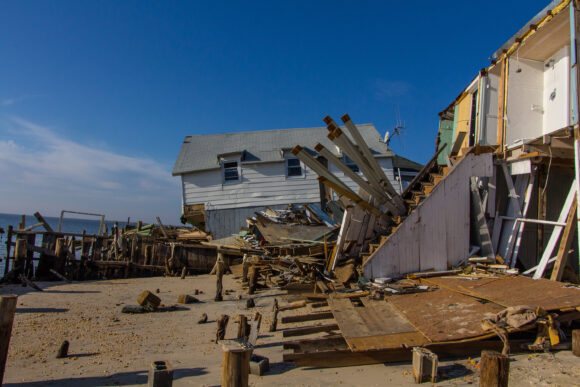Superstorm Sandy is poised to become one of the top three most expensive hurricanes in history.
With close to 1.4 million claims filed, Sandy is likely to be the third most expensive hurricane in U.S. history in terms of insured losses with 2012 adjusted dollars, followed only by Hurricane Katrina and Hurricane Andrew, says Frank Nutter, president of the Reinsurance Association of America.

The more than one million Sandy-related homeowner claims filed has sparked renewed interest in the wind versus wave debate as insureds try to understand their policy coverage terms.
To evaluate which peril caused damage in a hurricane or tropical storm, there must be an understanding of the forces involved, the experts say.
Storm surges were blamed for most damage caused in the past, says Dr. William Gray, professor emeritus of Atmospheric Science and head of the Tropical Meteorology Project at Colorado State University.
“It used to be that storm surge did 90 percent of the damage and the winds and rain did the other 10 percent. But that was too exaggerated,” he says. “If you have large size storms, you tend to have more damage from wind surge. It depends how the storm approaches the coastline and the configuration of the coastline.”
Unlike Superstorm Sandy, where waves caused most of the destruction, much of the damage caused by Hurricanes Andrew and Charley arose from wind, he said.
Force Differences
James Cohen, an associate principal at the New York office of Arup, and expert witness with close to 35 years of experience investigating structural failures, says when both wind and wave damage exists it can be difficult to determine which peril caused the damage.
There has been heated debate on the subject since Hurricane Katrina in 2005 because of the difficulty in determining such damage, Cohen said in a recent presentation.
There are differences in the forces behind wind and wave, however.
“Flood forces occur at ground level, and they can be very large, but they’re limited to the height of the water,” he said. For example, hydrostatic, dynamic, breaking waves, impact loads from floating debris. Wind on the other hand increases with height.
“Theoretically you have zero force at ground level, and it keeps going up as you get higher,” Cohen said. “You can have some impact loads, but unless you have a tornado carrying large objects, impact tends to be stones or something of that nature during a hurricane.”
The level of action between flood and wind differs in height as well.
“Flood is low, wind is high. The flood forces will be much larger, but will occur over a smaller area than wind, which can act over the entire height of the building, but generally has a much lower pressure than the water will give,” Cohen said.
Wind is less destructive than a storm surge, according to Jeffery H. Warren, chief engineer and CEO of The Warren Group in Columbia, S.C.
“For example, wind at 40 mph produces 7 pounds of pressure per square foot (psf) compared to a wave at 7 mph [which] produces 200 pounds of pressure psf. The average wooden roof is designed to sustain 30 psf, which means 80 mph winds are needed to cause considerable damage,” Warren explained.
“Storm surge is the combination of wind and low atmospheric pressure. It can range from three to four feet to 15 to 20 feet,” Warren said. One inch of falling barometric pressure is going to raise the water level about one foot.
“Although it is hard to imagine how strong water can be, remember a cubic yard of water (3 feet by 3 feet by 3 feet) weighs over three-quarters ton. A modest 4-foot wave striking an 8-10 foot wall could destroy it.” This is the reason building codes require structures to be built above the wave height, Warren said, which is the best way to mitigate a loss.
Careful attention must be paid in determining which force caused damage when both perils are present.
“It’s difficult if someone doesn’t know what to look for, because both can result in damage to siding, to walls,” he said. Buildings can be partially or totally demolished by both of them.
“If you have a hurricane, there will be water penetration, so you’ll have water damage. If you have a flood, there may be high winds as well, so you could have wind damage occurring along with the flooding,” he said. “You could have a building that has both types of damage.”
Damage Differences
When discernible, Cohen said there are differences in the damage each can cause.
Since flooding occurs at a lower level there tends to be residual water damage and staining.
“Wave acts at ground level and with a blunt force. It has the same type of fluid dynamics as wind would, with the drag forces on the side,” Cohen said. But waves also can scour the ground and undermine foundations. “Typically, it will be carrying objects which will impact the building or the structure directly. On the ground you’ll see flow patterns, which would be absent in a wind,” Cohen said.
Wind tends to result in localized damage and will initiate from the top down or through breached openings and upper wall failure.
Wind speed increases with height, according to Cohen. Wind forces are proportional to the square of the wind speed (two times speed equals four times force). Wind speeds are affected by topography (hills and escarpments), ground roughness. Forces and force distribution are also affected by building height and shape, as well as local obstructions.
“Wind acts at a high level. Flood forces won’t give you internal pressures. If you have an opening in a building, it’s more likely to relieve your flood forces. But if you have an opening in a building, your wind forces could be much higher, because you could build up internal pressures, sort of like blowing the balloon up, as your building would be,” he explained. “If it gets moved by wind, it’s going to have other damage to the siding, to the eaves, the gables, the roof.”
Some adjusters gauge the cause of damage by looking at the roof of a structure. If there is damage to the roof, it’s likely due to wind damage, according to Cohen. However, sometimes determining cause will be difficult.
“If you have a tornado acting at the same time as a flood, it’s hard to say which happens first. But if it’s a flood-only and your building is not there, you will find it downstream, and other things will be floating with it,” he said. There will be a consistency of ground-level type damage.
But if the building is not there, and it’s wind, the damage will be scattered far and wide. “Trees will also show signs of wind damage, whereas they may not show anything for flood. You look for the patterns around the area as well as the pattern of movement of what’s left of the building,” Cohen said.
The most common type of damage Cohen viewed from Hurricane Sandy included scour, something he described as local erosion, when water flows around a structure picking up the soil with it. The structural damage that results is foundation damage.
“That was the more common type of damage I saw from Hurricane Sandy,” he said. “The wind wasn’t really very high. The wind damage that I saw was really limited to some signage and roofing tiles; almost nothing else.”
Sandy’s flood damage included things such as caved in garage doors, or scour. “Some siding which had been ripped off,” he said. “The difference between siding being ripped off by wind versus flood is that the flood damaged siding was ripped off at ground-level, not at higher level,” Cohen said.
Was this article valuable?
Here are more articles you may enjoy.


 Palantir Poaching Suit Called ‘Scare’ Tactic by Ex-Employees
Palantir Poaching Suit Called ‘Scare’ Tactic by Ex-Employees  Musk’s X Probed by UK Over Grok’s Thousands of Sexualized Images
Musk’s X Probed by UK Over Grok’s Thousands of Sexualized Images  Munich Re: Insured Losses From Wildfires, Storms and Floods Hit Record High
Munich Re: Insured Losses From Wildfires, Storms and Floods Hit Record High  Allianz Built An AI Agent to Train Claims Professionals in Virtual Reality
Allianz Built An AI Agent to Train Claims Professionals in Virtual Reality 